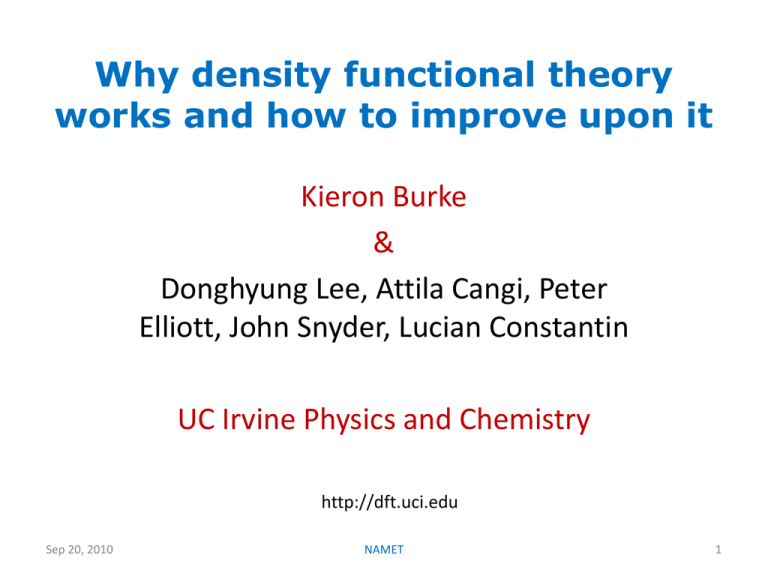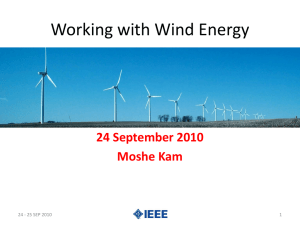Burke - www2.mpip
advertisement

Why density functional theory works and how to improve upon it Kieron Burke & Donghyung Lee, Attila Cangi, Peter Elliott, John Snyder, Lucian Constantin UC Irvine Physics and Chemistry http://dft.uci.edu Sep 20, 2010 NAMET 1 Outline a) Overview b) Some details Sep 20, 2010 NAMET 2 Modest statements • The most important problem I’ve ever worked on • Possible payoffs – Understanding of asymptotic approximations – Complete transformation of society • Explains many things about many areas – Semiclassical expansions – DFT and approximations like Thomas-Fermi • Ties together – – – – Math Physics Chemistry Engineering Sep 20, 2010 NAMET 3 Insults • Physicists – Is it possible that your most precious elegant little theories (e.g., many-body theory with Feynman diagrams) are a stupid approach to electronic structure? • Chemists – Would you rather continue with LCSF (linear combinations of successful functionals) or actually derive stuff? • Applied mathematicians – Do you want to spend the rest of your life proving things only 6 people care about, or would you rather do something useful? Sep 20, 2010 NAMET 4 Electronic structure problem What atoms, molecules, and solids exist, and what are their properties? May 5, 2010 Pitt1 5 Properties from Electronic Ground State • Make Born-Oppenheimer approximation • Solids: – Lattice structures and constants, cohesive energies, phonon spectra, magnetic properties, … • Molecules: – Bond lengths, bond angles, rotational and vibrational spectra, bond energies, thermochemistry, transition states, reaction rates, (hyper)-polarizabilities, NMR, … May 5, 2010 Pitt1 6 Big picture WKB Gutwiller trace 1d or 2d TF theory Lieb et al Atoms Exact conditions Perdew, Levy Empiricism Becke, Truhlar Modern DFT Kohn-Sham EXC[n↑,n↓] ochemistry Chemistry Sep 20, 2010 Condensed matter physics NAMET Materials science Astrophysics, protein folding, soil science,… 7 Thomas/Fermi Theory 1926 • Around since 1926, before QM • Exact energy: E0 = T + Vee + V – T = kinetic energy – Vee = electron-electron repulsion – V = All forces on electrons, such as nuclei and external fields • Thomas-Fermi Theory (TF): – – – – T ≈ TTF = 0.3 (3p)2/3∫dr n5/3(r) Vee≈ U = Hartree energy = ½ ∫dr ∫dr’ n(r) n(r’)/|r-r’| V = ∫dr n (r) v(r) Minimize E0[n] for fixed N • Properties: – Exact for neutral atoms as Z gets large (Lieb+Simon, 73) – Typical error of order 10% – Teller’s unbinding theorem: Molecules don’t bind. May 5, 2010 Pitt1 8 Modern Kohn-Sham era • 40’s and 50’s: John Slater began doing calculations with orbitals for kinetic energy and an approximate density functional for Exc[n] (called Xα) • 1964: Hohenberg-Kohn theorem proves an exact E0[n] exists (later generalized by Levy) • 1965: Kohn-Sham produce formally exact procedure and suggest LDA for Exc[n] May 5, 2010 Pitt1 9 Kohn-Sham equations (1965) 1 2 2 v s [n]r i r ii r N nr i r = ground-state density of interacting system 2 i 1 nr' v s r vext r dr' v xc [n]r r r' E0 TS V U EXC [n] May 5, 2010 Pitt1 Exc v xc [n]r nr 10 He atom in exact Kohn-Sham DFT Everything has (at most) one KS potential n(r ) vS (r ) Dashed-line: EXACT KS potential May 5, 2010 Pitt1 11 Recipe for exact Exc[n] • Given a trial density n(r) – Find the v(r) that yields n(r) for interacting electrons – Find the vs(r) that yields n(r) for non-interacting electrons – Find vH(r) (easy) – vxc(r)=vs(r)-v(r)-vH(r) – Can also extract Exc=E-Ts-V-U • Much harder than solving Schrödinger equation. • In fact, QMA hard (Schuch and Verstraete. Nature Physics, 5, 732 (2009).) May 5, 2010 Pitt1 12 Local (spin)density approximation • Write Exc[n]=∫d3r exc(n(r)), where exc(n) is XC energy density of uniform gas. • Workhorse of solid-state physics for next 25 years or so. • Uniform gas called reference system. • Most modern functionals begin from this, and good ones recover this in limit of uniformity. May 5, 2010 Pitt1 13 Subsequent development • Must approximate a small unknown piece of the functional, the exchange-correlation energy Exc[n]. • 70’s-90’s: Much work (Langreth, Perdew, Becke, Parr) going from gradient expansion (slowly-varying density) to produce more accurate functionals, called generalized gradient approximations (GGA’s). • Early 90’s: – Approximations became accurate enough to be useful in chemistry – 98 Nobel to Kohn and Pople May 5, 2010 Pitt1 14 Commonly-used functionals • Local density approximation (LDA) – Uses only n(r) at a point. • Generalized gradient approx (GGA) – Uses both n(r) and |nr)| – Should be more accurate, corrects overbinding of LDA – Examples are PBE and BLYP • Hybrid: – Mixes some fraction of HF – Examples are B3LYP and PBE0 May 5, 2010 Pitt1 15 Too many functionals May 5, 2010 Pitt1 16 Functional approximations • Original approximation to EXC[n] : Local density approximation (LDA) • Nowadays, a zillion different approaches to constructing improved approximations • Culture wars between purists (non-empirical) and pragmatists. • This is NOT OK. Sep 20, 2010 NAMET 17 Modern DFT development It must have sharp steps for stretched bonds May 5, 2010 It keeps H2 in singlet state as R→∞ Pitt1 It’s tail must decay like -1/r 18 Things users despise about DFT • No simple rule for reliability • No systematic route to improvement • If your property turns out to be inaccurate, must wait several decades for solution • Complete disconnect from other methods • Full of arcane insider jargon • Too many functionals to choose from • Can only be learned from another DFT guru Sep 20, 2010 NAMET 19 Things developers love about DFT • No simple rule for reliability • No systematic route to improvement • If a property turns out to be inaccurate, can take several decades for solution • Wonderful disconnect from other methods • Lots of lovely arcane insider jargon • So many functionals to choose from • Must be learned from another DFT guru Sep 20, 2010 NAMET 20 Difference between Ts and EXC • Pure DFT in principle gives E directly from n(r) – – – – Original TF theory of this type Need to approximate TS very accurately Thomas-Fermi theory of this type Modern orbital-free DFT quest (See Trickey and Wesolowsi talks) – Misses quantum oscillations such as atomic shell structure • KS theory uses orbitals, not pure DFT – Made things much more accurate – Much better density with shell structure in there. – Only need approximate EXC[n]. Sep 20, 2010 NAMET 21 Semiclassics in Coulomb potential Kieron’s trail of tears Bohr atoms: Vee=0 Include exchange 1d particles in wavy box V->0 at ∞ TF theory Lieb et al Atoms HF atoms Langer uniformization WKB Arbitrary 3d potential Include correlation All electronic structure calculations Real atoms Sep 20, 2010 Include turning points NAMET 22 The big picture • We show local approximations are leading terms in a semiclassical approximation • This is an asymptotic expansion, not a power series • Leading corrections are usually NOT those of the gradient expansion for slowly-varying gases • Ultimate aim: Eliminate empiricism and derive density functionals as expansion in ħ. Sep 20, 2010 NAMET 23 Basic picture • Turning points produce quantum oscillations – Shell structure of atoms – Friedel oscillations • There are also evanescent regions • Each feature produces a contribution to the energy, larger than that of gradient corrections • For a slowly-varying density with Fermi level above potential everywhere, there are no such corrections, so gradient expansion is the right asymptotic expansion. • For everything else, need GGA’s, hybrids, metaGGA’s, hyper GGA’s, non-local vdW,… Sep 20, 2010 NAMET 24 • Many difficulties in answering this question: – Semiclassical methods – Asymptotic expansions – Boundary layer theory Sep 20, 2010 NAMET 25 What we’ve done so far Semiclassical density, Elliott, PRL 2008 Bohr atoms, Snyder, in prep Corrections to local approx, Cangi, PRB 2010 Derivation of B88, Elliott, Can J Chem, 2009 Slowly varying densities, with Perdew, PRL 2006 Sep 20, 2010 Ionization in large Z limit, Constantin, sub. JCP, 2010 NAMET Exact conditions on PBEsol, Perdew et TS, D. Lee et al, PRA, al, PRL 2008. 2009 26 A major ultimate aim: EXC[n] • Explains why gradient expansion needed to be generalized (Relevance of the slowly-varying electron gas to atoms, molecules, and solids J. P. Perdew, L. A. Constantin, E. Sagvolden, and K. Burke, Phys. Rev. Lett. 97, 223002 (2006).) • Derivation of b parameter in B88 (Non-empirical 'derivation' of B88 exchange functional P. Elliott and K. Burke, Can. J. Chem. 87, 1485 (2009).). • PBEsol Restoring the density-gradient expansion for exchange in solids and surfaces J.P. Perdew, A. Ruzsinszky, G.I. Csonka, O.A. Vydrov, G.E. Scuseria, L.A. Constantin, X. Zhou, and K. Burke, Phys. Rev. Lett. 100, 136406 (2008)) – explains failure of PBE for lattice constants and fixes it at cost of good thermochemistry – Gets Au- clusters right Sep 20, 2010 NAMET 27 Structural and Elastic Properties Errors in LDA/GGA(PBE)-DFT computed lattice constants and bulk modulus with respect to experiment → Fully converged results (basis set, k-sampling, supercell size) → Error solely due to xc-functional → GGA does not outperform LDA → characteristic errors of <3% in lat. const. < 30% in elastic const. → LDA and GGA provide bounds to exp. data → provide “ab initio error bars” Blazej Grabowski, Dusseldorf Inspection of several xc-functionals is critical to estimate Seppredictive 20, 2010 power and error bars! NAMET 28 Essential question • When do local approximations become relatively exact for a quantum system? • What is nature of expansion? • What are leading corrections? Sep 20, 2010 NAMET 29 Need help • • • • • • • Asymptotic analysis Semiclassical theory, including periodic orbits Boundary layer theory Path integrals Green’s functions for many-body problems Random matrix theory E.g., who has done spin-decomposed TF theory? Sep 20, 2010 NAMET 30 What we might get • We study both TS and EXC • For TS: – Would give orbital-free theory (but not using n) – Can study atoms to start with – Can slowly start (1d, box boundaries) and work outwards • For EXC: – Improved, derived functionals – Integration with other methods Sep 20, 2010 NAMET 31 Outline a) Overview b) Some details Sep 20, 2010 NAMET 32 One particle in 1d Sep 20, 2010 NAMET 33 N fermions Sep 20, 2010 NAMET 34 Rough sums Sep 20, 2010 NAMET 35 Inversion Sep 20, 2010 NAMET 36 Higher orders Sep 20, 2010 NAMET 37 Test system v(x)=-D sinp(mπx) Sep 20, 2010 NAMET 38 Semiclassical density for 1d box TF Classical momentum: Classical phase: Fermi energy: Classical transit time: Elliott, Cangi, Lee, KB, PRL 2008 Sep 20, 2010 NAMET 39 Density in bumpy box • Exact density: – TTF[n]=153.0 • Thomas-Fermi density: – TTF[nTF]=115 • Semiclassical density: – TTF[nsemi]=151.4 – DN < 0.2% Sep 20, 2010 NAMET 40 Usual continua • Scattering states: – For a finite system, E > 0 • Solid-state: Thermodynamic limit – For a periodic potential, have continuum bands Sep 20, 2010 NAMET 41 A new continuum • Consider some simple problem, e.g., harmonic oscillator. • Find ground-state for one particle in well. • Add a second particle in first excited state, but divide ħ by 2, and resulting density by 2. • Add another in next state, and divide ħ by 3, and density by 3 • … • →∞ Sep 20, 2010 NAMET 42 Continuum limit Leading corrections to local approximations Attila Cangi, Donghyung Lee, Peter Elliott, and Kieron Burke, Phys. Rev. B 81, 235128 (2010). Attila Cangi Sep 20, 2010 NAMET 43 Example of utility of formulas • Worst case (N=1) • Note accuracy outside of turning points • No evanescent contributions in formula Sep 20, 2010 NAMET 44 Getting to real systems • Include real turning points and evanescent regions, using Langer uniformization • Consider spherical systems with Coulombic potentials (Langer modification) • Develop methodology to numerically calculate corrections for arbitrary 3d arrangements Sep 20, 2010 NAMET 45 Classical limit for neutral atoms • For interacting systems in 3d, increasing Z in an atom, keeping it neutral, approaches the classical continuum, ie same as ħ→0 Sep 20, 2010 NAMET 46 Ionization as Z→∞ Lucian Constantin Using code of Eberhard Engel Sep 20, 2010 NAMET 47 Z→∞ limit of ionization potential • Shows even energy differences can be found • Looks like LDA exact for EX as Z-> ∞. • Looks like finite EC corrections • Looks like extended TF (treated as a potential functional) gives some sort of average. • Lucian Constantin, John Snyder, JP Perdew, and KB, arXiv. Could we get accurate results with QMC? See Richard Needs, PRE, 2005. Sep 20, 2010 NAMET 48 Ionization density for large Z Sep 20, 2010 NAMET 49 Ionization density as Z→∞ Sep 20, 2010 NAMET 50 Bohr atom • Atoms with e-e repulsion made infinitesimal x=Z1/3r, Z=28 Sep 20, 2010 NAMET 51 Exactness for Z→∞ for Bohr atom Using hydrogenic orbitals to improve DFT John C Snyder Sep 20, 2010 NAMET 52 Orbital-free potential-functional for C density 4pr2ρ(r) r Sep 20, 2010 NAMET 53 C+ I=11.26eV ΔI=0.24eV I(LSD)=11.67 eV Sep 20, 2010 NAMET 54 Outline a) Overview b) Some details Sep 20, 2010 NAMET 55 Third prize • Will be able to see directly the nature of semiclassical corrections, and calculate them for simple systems • Can build better density functional approximations which capture these limits • Remove empiricism in functional construction – Get parameters from limits – Knowing which exact conditions to apply Sep 20, 2010 NAMET 56 Second prize • Able to say what approximation to Green’s function or wavefunction gives rise to density functional approximation. • Able to perform more accurate calculations in vital part of system, and stitch on to DFT calculation. • Know what a DFT approximation means Sep 20, 2010 NAMET 57 First prize • Extract kinetic energy directly from vS(r) without solving KS equations • Extract EXC directly from v(r) without needing the density • Replace DFT with potential functional theory using semiclassical expansions for energies from potential. • Speed up all calculations tremendously. Sep 20, 2010 NAMET 58 Conclusions • All work in progress – Rome was not burnt in a day • For EXC: – Already have bits and pieces – Beginning assault on EX[n] • For TS: – Strongly suggests orbital-free calculations should use potential not density – Now have improved formula for getting T directly from any n[v](r) – Developing path-integral formulation • Thanks to students and NSF Sep 20, 2010 NAMET 59




